Citizens' forums, and attitudes to agriculture, environment and rural priorities: research report
Results of an independent study into Scottish public attitudes to the environment, agriculture and rural development.
High quality food production
A key guiding principle for future agri-policy is the focus on ensuring high quality food production is at the heart of Scottish agriculture. Underpinning this view are perceptions of the value of agriculture, and also considerations of a range of factors which inform choices about food consumption and production.
As shown later in this chapter, local food production and quality of food are seen interchangeably and Scottish consumers want to ensure that they are supported to balance between cost, quality, and local food produce, when making choices about food consumption.
Perceptions of the value of agriculture
Exploring perceptions of Scottish agriculture there was widespread agreement (86%) that Scottish farming is vital for the success of the Scottish economy. A similar proportion (83%) agreed that Scottish farming provides a vital public service to the people in Scotland.
Figure 2.1: Perceptions of the value of agriculture
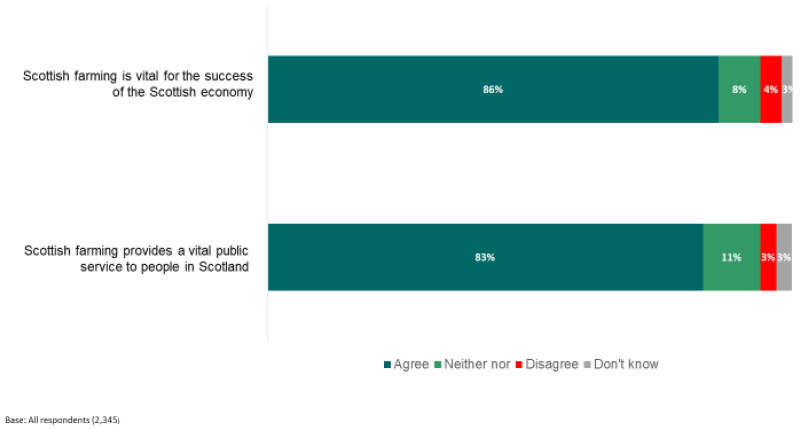
Women were more likely than men to value the contribution of agriculture to the Scottish economy (89% compared with 82%); and conceive of agricultural as a vital public service (84% compared with 81%).
The concept of Scottish farming as a vital public service was further explored at the Citizens' Forums, not least given the common framing of agriculture as a "public service" or "public good" in public policy discourse. An initial discussion to obtain first reactions to the concept was followed by a presentation delivered by Professor David Hopkins, Dean of the Central Faculty of Scotland's Rural College. The presentation outlined the contribution agriculture makes to the Scottish economy, and the role agriculture plays in land stewardship and protecting the environment, as well as financial support provided to the agricultural sector. Exploring views before and after the presentation enabled an evaluation of whether views on the issue change with the provision of information.
Reflecting the survey results, participants at the Forums overwhelmingly agreed or strongly agreed that Scottish farming provides a vital public service. Having said that, this was by no means a universal view and a minority of participants (n=4) were less convinced by the concept, providing a response at the mid-point of the agreement scale. After the presentation and discussion, almost all participants more strongly agreed with the statement, a minority however lessened their expression of agreement moving from strongly agree to agree.
The direction of travel in the views from the survey to the various points of the deliberative process are shown in the table below.
The results indicate that perceptions of Scottish agriculture providing a vital public service are strengthened through deliberation on the issue; however, it should be noted that results were strong in this regard to begin with, and the deliberative process helped to reaffirm this position.
Table 2.1 Change in views on whether Scottish agriculture provides a vital public service
| Strongly agree % | Tend to agree % | Neither nor % | Tend to disagree % | Strongly disagree % | |
|---|---|---|---|---|---|
| Survey | 46% | 40% | 8% | 3% | 1% |
| 1st response Motherwell | 91% | 5% | 5% | 0% | 0% |
| 1st response Montrose | 35% | 46% | 15% | 4% | 0% |
| After 2 days deliberation | 51% | 39% | 8% | 0% | 0% |
Subsequent discussions at the Forums point to some of the reasons behind the high-level agreement that Scottish farming provides a vital public service. In particular, participants emphasised the "financial benefit {of agriculture} to the economy" reflecting the information shared with participants about the financial contribution of the sector. Importantly, participants pointed to the creation of jobs by the sector and in particular providing "vital employment to rural communities." There was also a discussion that "if it is well managed," farming can have a positive "impact on the environment," including "maintaining waterways," and "keeping soil fertility," among other aspects.
Furthermore, there was a perception that Scottish agriculture helped to make Scotland self-sufficient: "be[ing] able to produce its own food and not rely on other countries and policies" helped to deliver a vital public service to Scotland in terms of food security. Participants attributed value to supporting local food production both in economic terms but also as participants placed an emphasis on the quality of food sourced locally as it was seen to be "fresher, healthier and supports the ecosystems."
Another common theme was the linkages between Scottish farming and Scottish identity and history. Farmers were described as "keepers of our countryside," and there was an emphasis on farming as part of Scotland's "historical landscape and identity, there to be cultivated," and that there was a responsibility among farmers to "retain historic skills/crofts that would otherwise be lost to future generations."
There was also some discussion among those who were not entirely convinced that agriculture provides a vital public service. A range of reasons were cited including the view that "income / expenditure in today's climate does not contribute enough to the economy", and that "most food produce is imported". There was also the view that there is a disparity between "very poor and very rich farmers" which meant that the sector did not provide a vital public service as it was unequal.
On the issue of financing and supporting agriculture, there is a significant relationship found in the survey data between the perception that Scottish farming provides a vital public service and the view that Scottish farmers do not receive a fair share of money for the food they produce. The results indicate that there is appetite for further support for farming and food production among those who view the sector as providing a public service which resonates with the framing of the current subsidies policy. The issue of spending allocations for farming and agriculture are explored in more detail later in the report.
Table 2.2. Views on whether Scottish agriculture provides a vital public service by whether Scottish farmers receive a fair share of money for the food they produce (col. %)
| Scottish farmers receive a fair share of money | Scottish farming provides a vital public service | |||
|---|---|---|---|---|
| Agree % | Neither % | Disagree% | Don't know % | |
| Agree | 74 | 77 | 91 | 79 |
| Neither nor | 19 | 24 | 5 | 6 |
| Disagree | 6 | 2 | 2 | 3 |
| Don't know | 1 | * | 2 | 13 |
Discussion around the issue of farming as a public good is pertinent given that food production is a private enterprise[5], however there is a view in the literature that farming can provide public goods if it presents value for money or confers other benefits to the public such as protecting and conserving the natural environment. However, Bateman 2017, note that the degree to which farms can deliver public goods will differ markedly by location e.g. some areas such as peatlands are conducive to carbon storage, or recreational and mental health benefits from woodland can be delivered only if they are in proximity to populations[6]. Therefore, there is a view that public benefits from farming should be demonstrable to the public and may differ depending on location which is markedly different from a blanket value judgement of the issue.
Priorities for food consumption
The research identified the factors that consumers prioritise when choosing what to eat. More broadly this has implications for the preferred funding and support for agriculture, considering the range of factors that are most important in terms of food consumption/production.
Animal welfare (21%), impact on health (20%), and cost (19%), were the most commonly cited "essential" factors that inform decisions about food consumption. These results are consistent with previous research on attitudes to food and diet[7].
Figure 2.2: Priorities for food consumption
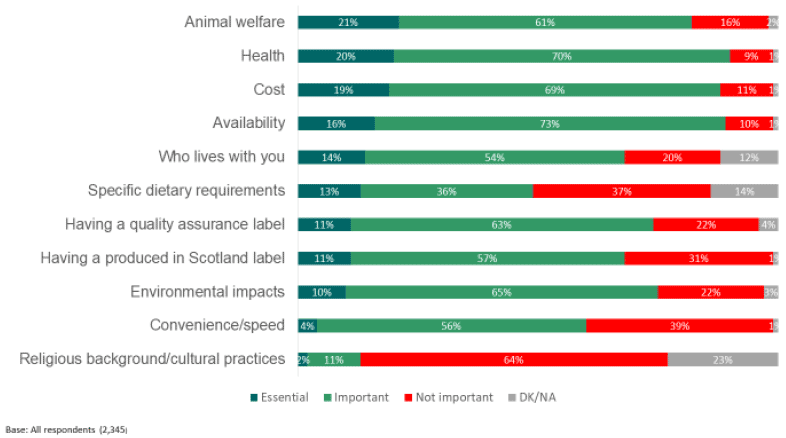
There is a correlation among these factors and social grade, with cost being more of an essential or important factor for those in the C2DE social grade[8] category comparative to those in the ABC1 social grade category; and conversely health and animal welfare being more of an essential or important factor for those in the ABC1 social grade category than C2DE social grade. Notably, previous research has identified that cost is seen as one of the main barriers to healthy eating[9].
In addition, there was some notable variation by a range of different demographic factors:
- The availability of food items in the shops near you, was more likely to be an essential factor for those residing in remote rural locations than overall (27% compared with 16%).
- The impact on health, was more important for older age groups than overall (45% of 65+ said it was very important compared with 35% overall).
- Animal welfare was more likely to be cited as an essential factor among women than men (24% compared with 17% among men).
Qualitative in-depth interviews provide insight into some of the most commonly cited food consumption factors. There was a perception that cost, and availability go hand in hand. In essence, there was a view that cost was a limiting factor in purchasing fresher foods; and there was a limited availability of fresher foods within specific neighbourhoods.
"I want to make a fresh salad for lunch, but the variety of ingredients needed make it expensive to put together" (Interview participant)
"If you are in a deprived postcode then the local shops are stocked with alcohol and crisps" (Interview participant)
"Readymade food is cheaper and then you don't have the added fuel costs in preparing the food" (Interview participant)
The availability of certain types of food was exacerbated for those living in rural communities. For those from small commuter towns there was a perception of a lack of shops in the area as residents typically travel to nearby urban areas where they do most of their shopping. On the other hand, for those living in island communities, there was mention of the impact of changes to the ferry schedules (which is frequent in bad weather) on the supply of food from the mainland. This led to "panic-buying" and shops often running out of stock for basic supplies.
"There are changes being made to the bus schedules which will mean that it will take 1 hour to get to the nearest supermarket and a slow service on Sundays" (Interview participant)
"Last year the ferry didn't sail for three days and we didn't have any milk. We normally stock up on food in the chest freezer but sometimes the shops run out" (Interview participant)
While the most common factors for the population as a whole related to animal welfare, health and cost; dietary requirements were a primary concern for those with special diets.
Specific diets encompassed those on gluten-free diets who were restricted to the gluten-free options available in supermarkets; taste, option and cost of food were also seen to be affected by the gluten-free diet factor.
"There is one shelf which stocks gluten free options and the bread doesn't taste that good either" (Interview participant)
"I'm severely gluten intolerant so I have to be careful with what I'm eating…I always check the labels" (Interview participant)
In a similar vein, those with specific food allergies and intolerances described the difficulties of checking food items for certain ingredients and cited a reliance on eating fresher food options as they contained less additives and gave them more control in terms of what they were consuming. While this was seen to be the "healthier option", there was the view that these food items tend to be more expensive than frozen and canned foods which are more cost-effective for larger families.
In contrast to those who described having to adopt specific diets because of their allergies or intolerances, there were also those who willingly adopted specific diets, such as dairy free, or sugar free, as a measure to improve their health. Those on such diets were consuming alternatives such as sugar free options, and almond or coconut milk. Indeed, those in this category described their diet more in terms of choice; this was in part related to income, as those who willingly made changes to their diet this way were typically of the ABC1 social grade category.
There were also those who adopted specific diets based on their cultural, religious and environmental views.
For instance, vegan and vegetarian dietary preferences stemmed from attitudes towards animal welfare and environmental concerns regarding the impact of food production on the environment.
"I wouldn't eat anything that I wouldn't kill myself" (Interview participant)
"The whole mass production system is unsustainable; we are feeding animals to kill them to feed us" (Interview participant)
Considering the range of different factors that inform choices about food consumption, the Citizens' Forums drilled into the decision-making in more detail by presenting participants with a series of binary choices to explore the choices, and trade-offs made by consumers when making decisions about the food they consume. In designing this exercise, the binary choices involved a combination of factors that impact the individual and factors that affect society.
Healthier Food vs Cheaper Food
Participants were presented with the binary choice of healthier or cheaper food and were asked to consider what was the most important factor for them. Overall, participants from both Citizens' Forums prioritised healthier food over cheaper food. In Motherwell, 59% cited healthier food as having a greater impact on their choice and in Montrose this figure increased to 64% of participants.
When discussing the results in groups, participants recognised that "it depends on income" and that people might choose cheaper food because the "costs are high, and the living wage is not enough". Other participants noted that "people have different ways of shopping," and "it depends who lives with you". One participant noted that "healthier is not always expensive", pointing out that the two factors are not mutually exclusive.
Figure 2.3: Healthier Food vs Cheaper Food
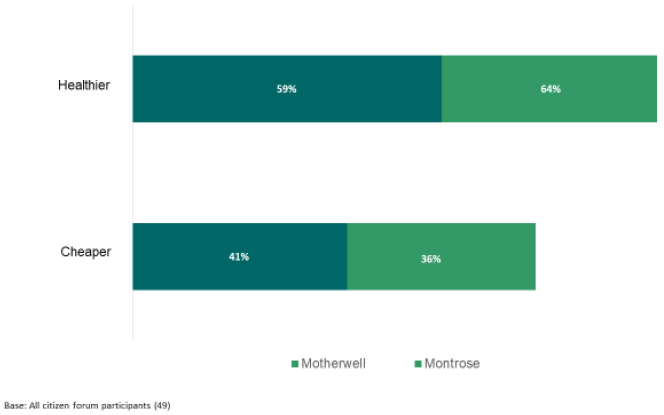
Cost vs Animal Welfare
Participants were then asked if the cost of food or animal welfare is the more important factor in terms of their food choices. There was mixed opinion on both of the issues. While participants in Motherwell were split 50-50, slightly more than half of the participants in Montrose (57%) said that the cost of food had a greater impact.
In discussions, participants pointed to "supermarket deals" and their "habit to pick up the cheaper one of two options" being why cost has an impact on their food choices. Participants said that "people don't know/switch off to what animal welfare means" although this might "depend where you come from - rural/urban".
Figure 2.4: Cost vs Animal Welfare
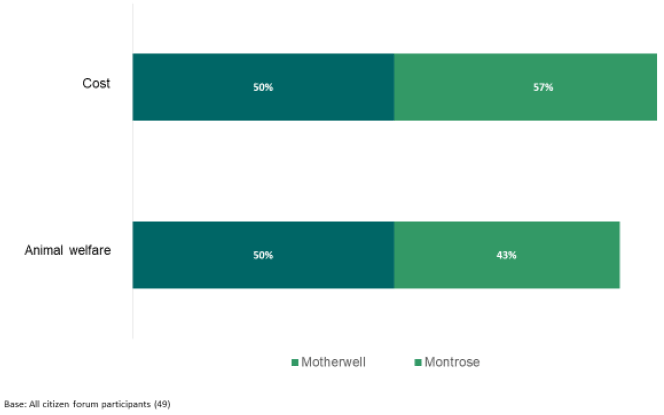
The foregoing results go beyond the headline survey results which identify animal welfare, cost, and impact on health as the most important factors underpinning choices about food consumption. When trade-offs need to be made, cost trumps animal welfare, and health trumps cost which shows that when presented with a binary choice there is a tendency to prioritise factors that affect the individual as opposed to factors that affect society.
Healthier Food vs Food that is Better for the Environment
Reflecting the pattern of findings whereby participants were more likely to select factors that affect them individually, there was a clear preference for choosing healthier food compared with food that is better for the environment. Results are almost identical in both locations, where the vast majority of participants (85% and 86% respectively) voted in favour of healthier food, and only a small subset of the sample preferred food that was better for the environment (14 and 15% respectively).
In conversations around this choice, participants highlighted that when buying food "you think of yourself first" and that considerations about the "environmental aspect is much broader" and "more removed" for people e.g. most "people are not as linked to the land and don't consider how food gets to their plate."
Figure 2.5: Healthier Food vs Food That is Better for the Environment
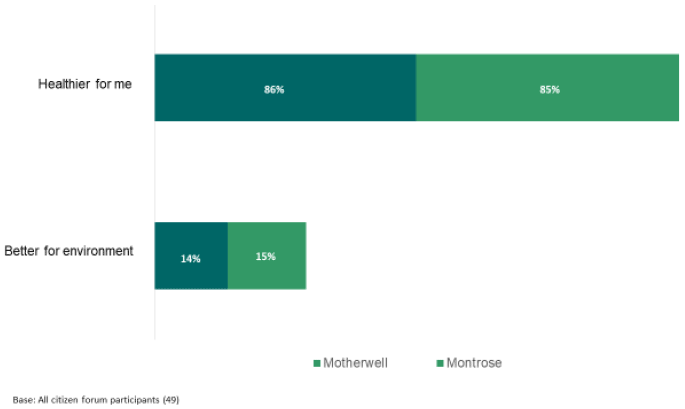
Food that is Better for the Environment vs Better Animal Welfare
When considering animal welfare and the environment in juxtaposition, there was a clear preference for the former over the latter. In 'urban' Motherwell, 57% of participants felt animal welfare had a greater impact on their choices while in 'rural' Montrose, almost three quarters (73%) of participants said animal welfare was a greater consideration than the environment in determining their choices about food.
Participants reflected that often the two aspects went hand-in-hand and that "good environmental protection equals good animal welfare, but bad environmental protection equals bad animal welfare". Participants also noted that in their minds, "high animal welfare equals better quality food" which may help to explain why animal welfare is a clear preference for participants given the value attributed to the quality of food.
Some participants, particularly from Montrose felt that the results of the question might be different if more people in general were actually more exposed to the slaughter of animals because "people are not as linked to the land and don't consider how food gets to their plate."
Figure 2.6: Food That is Better for the Environment vs Better Animal Welfare
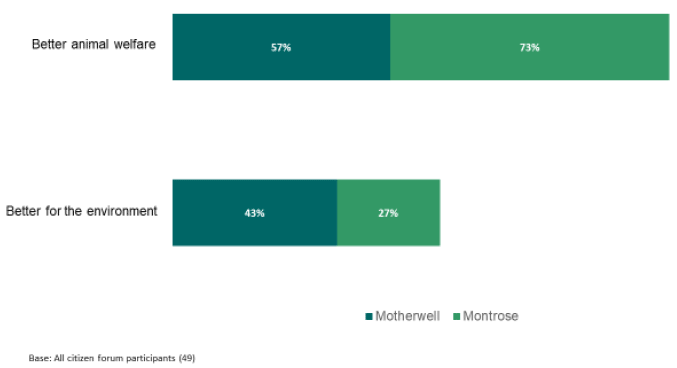
Locally Produced Food vs Better Quality Food
When considering locally produced food or better quality food, there was a slight variance in the results by location. In Motherwell, almost two-thirds (64%) of participants chose locally produced food as having the most influence on their food choices. In contrast, participants in Montrose were split between the two options: 52% choosing better-quality food and 48% choosing locally produced food.
Discussions from both locations revealed that for participants, their choice for locally produced food was because it is "important for local business". They said "locally-sourced implies high quality" and that "Scotland equals quality" even if visually that means buying "wonky veg." One caveat from participants was that they "want to support local producers, but not if it is not as good". Therefore, there is a view that locally sourced food is of better quality.
Figure 2.7: Locally Produced Food vs Better Quality Food
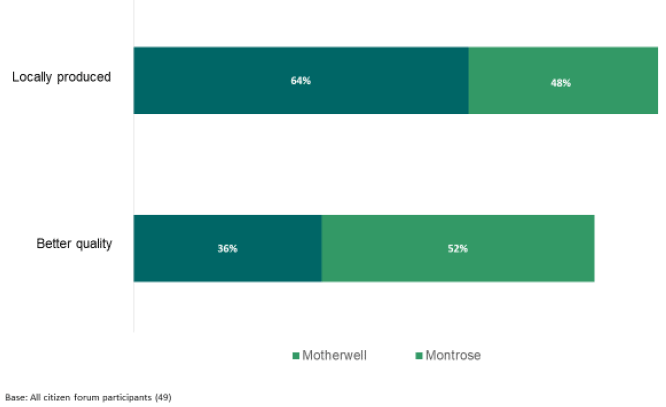
In subsequent discussions there was a view that consumers need more support to balance the priorities of cost, quality and local food production because these factors are not mutually exclusive. While some of the other factors trumped cost in the binary choices, there was a recognition that for some participants cost will always be the most pertinent factor, therefore producers should focus on a balanced ratio of cost-quality-locally sourced food production.
This is pertinent in terms of the type of support provided to the agricultural sector; indeed, there is a desirability of consuming more locally sourced food however consumers also need the food they purchase to be cost-effective.
The desirability of locally sourced food was expressed more strongly at the Citizens' Forums comparative to the survey results. This may be down to the time taken to explore the value and contribution of agriculture to the Scottish economy and its role in supporting local jobs.
Indeed, a relatively small proportion of the survey sample said that it was important their food produced in their region of Scotland (3%), or that food is produced in their local community (2%).
Figure 2.8: National Survey - The importance of where food is produced
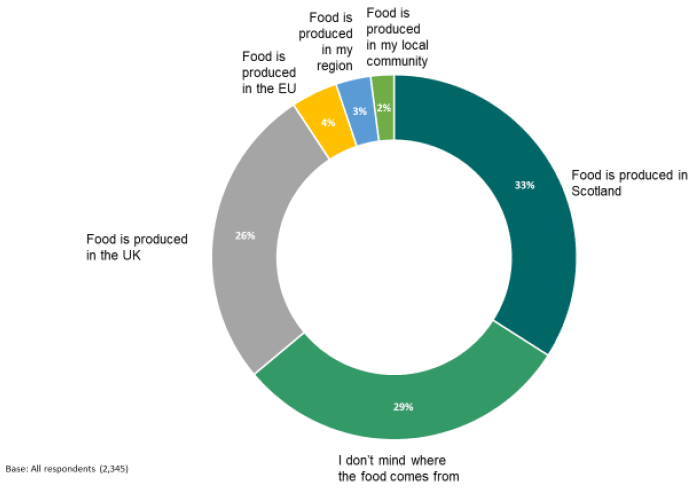
However, those in remote rural locations were more likely than overall to say that it was important that food is produced in their local area (8% compared with 2% overall).
The location of food production was also explored at the Citizens' Forums and the issue showed significant movement in attitudes pre-and-post deliberation.
In the pre-deliberation survey almost a quarter (24%) of participants indicated that they didn't mind where food comes from.
Figure 2.9: Citizens' Forums pre-deliberation - The importance of where food is produced
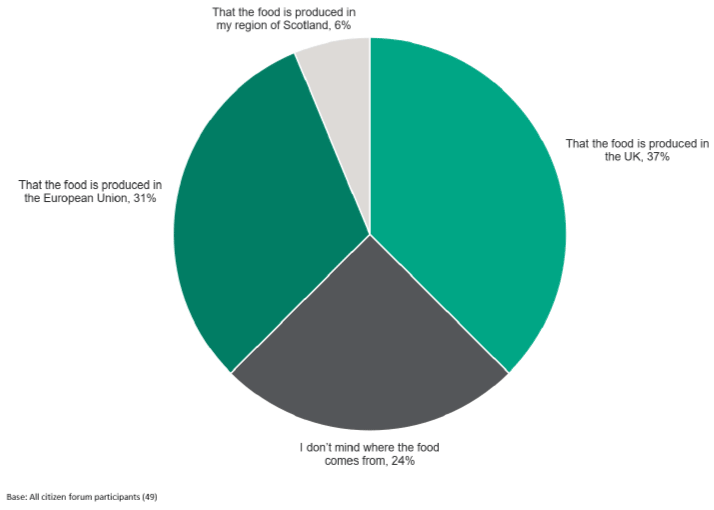
However, when the same question was asked at the end of the deliberative process, the results were quite different. At the post-deliberation point almost half (49%) of participants stated that it was important to them that the food they consume was produced in Scotland, with a further 18% stating that is was important to them that their food was produced in the UK.
Figure 2.10: Citizens' Forums Post deliberation - The importance of where food is produced
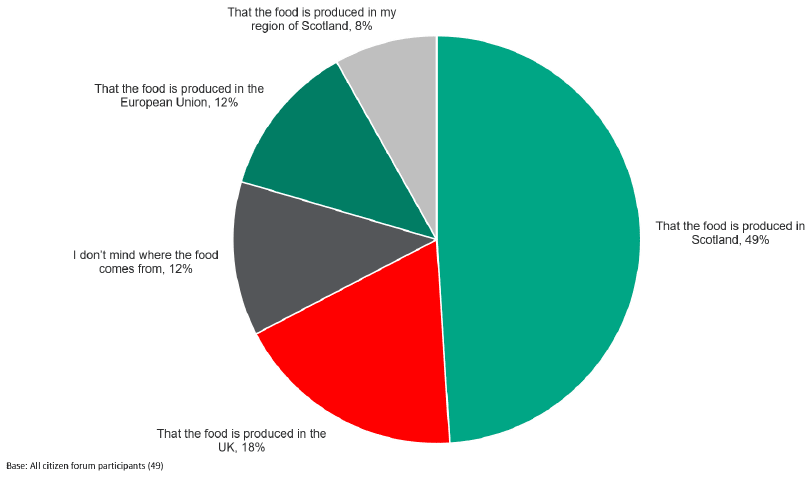
Further to the prioritisation of the various factors that affect consumer choices about food consumption, there was a recognition that Brexit may have a negative impact on a range of factors. Importantly, 68% think that Brexit will have a negative impact on cost which is one of the most essential factors driving food consumption choices.
Figure 2.11: Views of the effect that Brexit might have on food consumption issues
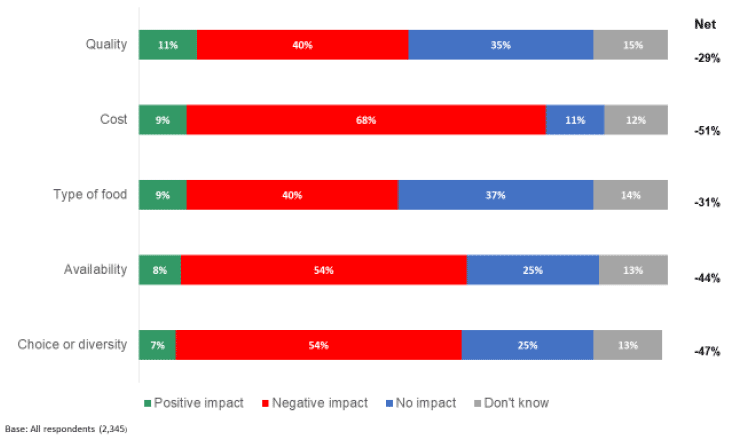
For all factors, those in the ABC1 social grade category were more likely than those in the C2DE social grade category to think that Brexit will have a negative impact.
Table 2:3. Impact of Brexit on food consumption issues by social grade
| Overall % | ABC1 % | C2DE % | |
|---|---|---|---|
| Quality | 40 | 43 | 36 |
| Cost | 68 | 71 | 64 |
| Type of food | 40 | 44 | 36 |
| Availability | 54 | 59 | 49 |
| Choice or diversity | 54 | 58 | 50 |
Another important variation is age whereby younger age groups were more likely than older age groups to think that Brexit will have a negative impact on a range of food consumption factors.
Table 2.4. Impact of Brexit on food consumption issues by age (% negative impact)
| Negative impact % | Overall % | Under35 % | 35-44 % | 45-54 % | 55-64 % | 65+ % |
|---|---|---|---|---|---|---|
| Quality | 40 | 46 | 41 | 41 | 38 | 30 |
| Cost | 68 | 76 | 71 | 70 | 65 | 55 |
| Type of food | 40 | 44 | 44 | 41 | 39 | 33 |
| Availability | 54 | 61 | 57 | 55 | 50 | 45 |
| Choice or diversity | 54 | 62 | 57 | 55 | 51 | 45 |
In the qualitative in-depth interviews, concerns arising from Brexit were spontaneously mentioned. Food security, and the availability of certain types of imported foods was commonly mentioned as a priority for the sector. There was recognition that Scottish agriculture in and of itself is not sustainable and there is a reliance on food commodities from the Continent; the free flow of which would be affected by the withdrawal from the Common Market.
"It is imperative that Scotland has some sort of European Free Trade Agreement to create a good environment for the trade of food products because we can't grow everything here" (Interview participant)
"Exports that took minutes will take longer which makes it impossible for perishable foods" (Interview participant)
There was also the issue of food quality standards and a concern that these would decrease after Brexit as the EU has stringent conditions on quality and labelling. In addition to this, there was a perception that the available funding for research and innovation in the agricultural sector and grant funding to subsidise farmers would decline - particularly given the period of economic austerity experienced in the UK.
Considering the foregoing results, priorities for the future of food production and consumption in Scotland included ensuring that food is healthy and safe (58%); ensuring affordable prices for consumers (49%); ensuring fair prices for producers (42%); ensuring sustainable food production and that food is good quality (39% respectively).
Figure 2.12: Priorities for the future of farming and food production
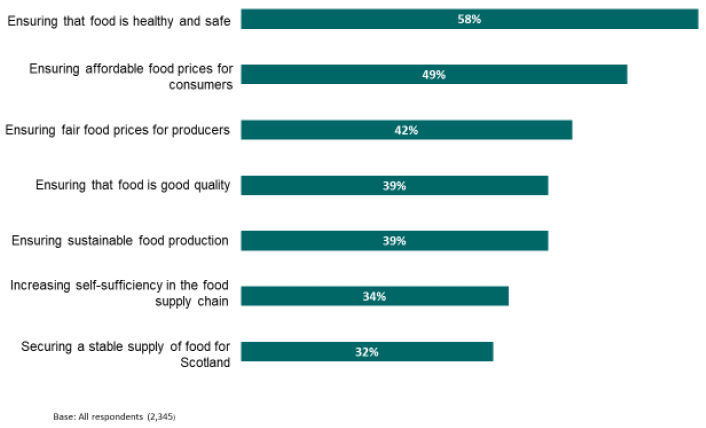
Points of consideration:
- Messaging around agriculture as a "public good"/ "public service" resonates with the public and is useful in framing future agri-policy however it is noted that the degree to which farms can deliver public goods will differ markedly by location, therefore the public good needs to be demonstrable for this framing to hold true;
- The public want more support for producers to sell locally and for consumers to purchase locally - however local food produce needs to be balanced with the priorities of cost and quality of food production;
- There is appetite for more information on the origins of food, so the public is more conscious of the priorities of animal welfare and the environment when considering food consumption and production;
- There is an acknowledgment that if future agriculture policy advances environmental and animal welfare principles, then consumers need to be prepared to accept imperfections in the aesthetics of food;
- There are concerns arising from Brexit around the sustainability of food production as well as quality standards and cost which need to be addressed in future policy. This may require future policy to harmonise or exceed EU quality standards, but also ensure support is in place to maintain the costs of production and the costs of food to the consumer.
Contact
There is a problem
Thanks for your feedback